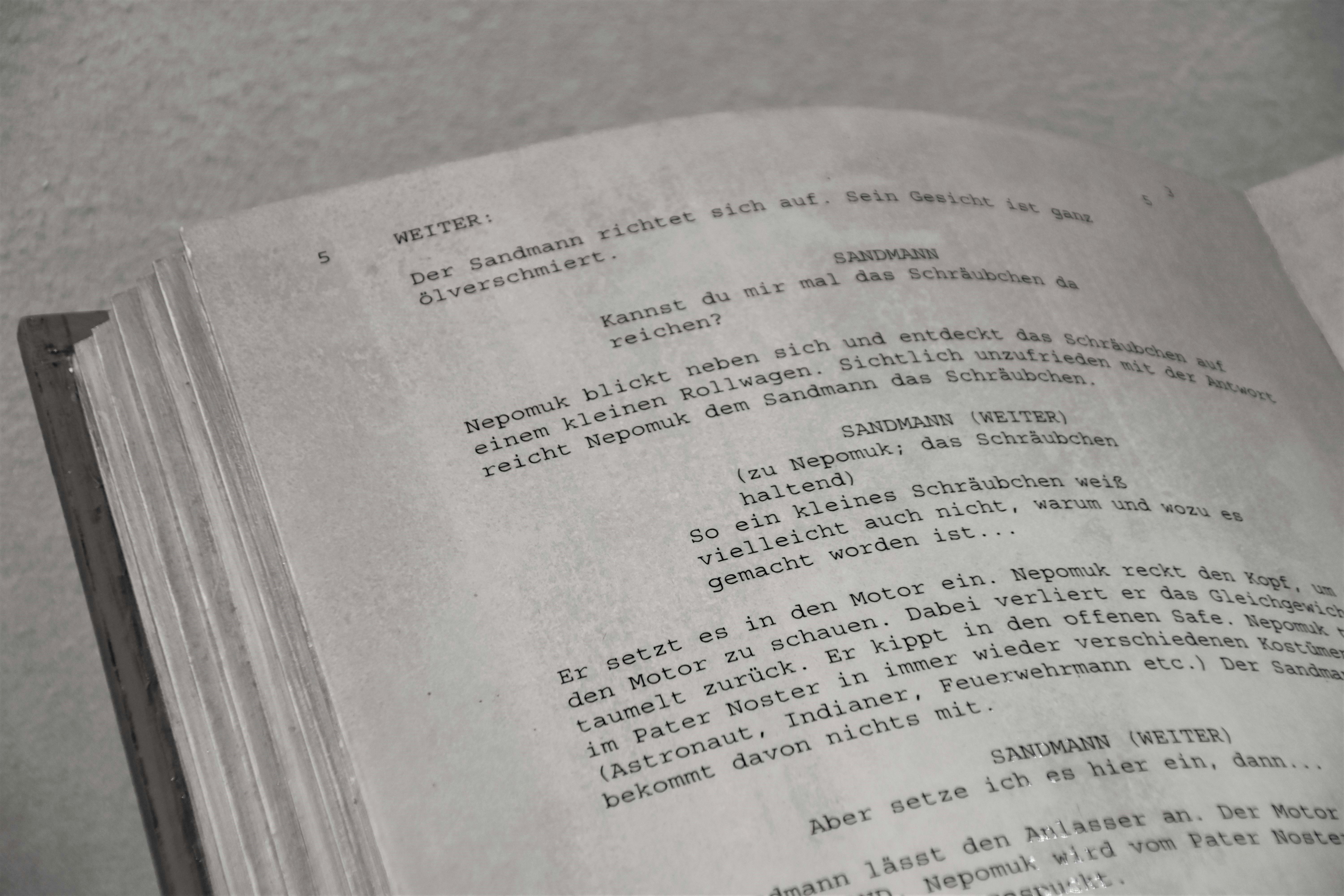How to Plan Your Screenplay Using the Save The Cat Beat Sheet: Tips and Template
Evolved from the classic Three-Act structure, the Save The Cat structure was coined by Blake Snyder himself. Read on for a guide and a template for your very own Save The Cat beat sheet!

Every screenplay writer — aspiring, beginner or seasoned — most likely knows about the classic 3 act structure used in many films. However, for those free-spirited souls who dare to step outside the box, why not consider looking into the Save The Cat story structure?
In this article, we'll be exploring how you can create a Save The Cat beat sheet to incorporate this interesting narrative structure into your own screenplay, as well as a writing program that you can use to write your very own Save The Cat beat sheet.
What is a beat sheet?

Photo by Waldemar Brandt on Unsplash
If you're an aspiring screenwriter, you may not be familiar with what a beat sheet is. In short, it's a summarized or condensed version of your screenplay, and is made up of "story beats". Story beats are key story events and scenes that impact the story or the characters, which makes a beat sheet a blueprint of your entire story.
Breaking down the Save The Cat Beat Sheet

Photo by Anete Lūsiņa on Unsplash
Fortunately for our animal lover readers, the Save The Cat beat sheet does not, in fact, involve an actual cat. This narrative structure originated from American screenwriter Blake Snyder's book "Save The Cat", in which he breaks the traditional 3 act plot structure further down into 15 story beats. He even goes a step further and gives a suggested number of pages for each story beat.
The Save The Cat beat sheet serves as an excellent way for you to outline your screenplay in detail. So, let's break down what these 15 story beats are, and how you can write them.
1. The Opening Image (page 1)
First, create your opening image! As name suggests, this is the very first thing that your audience will see when watching your screenplay. The opening image may seem insignificant, but it actually helps to set the theme or the mood of your overall screenplay.
For example, the opening image of a horror movie might be an eerie shot of the haunted house that your film will take place in.
2. Theme Stated (page 5)
"The Theme Stated moment of a movie is vital; it's what your movie is about." - Blake Snyder
Source: The Moment of Clarity by Blake Snyder
The theme of the film is usually communicated by a character at the beginning of the story, in a single scene beat usually 5 pages into your screenplay. It's the ultimate takeaway you intend for your audience (and your characters) to have by the end of your screenplay.
To illustrate this, the Theme Stated moment in The Titanic is when Jack (Leonardo DiCaprio) toasts the wealthy individuals he's dining with, and says "Make each day count."
3. The Set-up (pages 1-10)
The set-up should take place within the first 10 pages of your screenplay, and this is where you should introduce the important parts of your screenplay. Here are several things you should introduce:
- Your protagonist's status quo; their current life and surroundings
- Your protagonist's main goal
- Any character that will be relevant to your main story beats. You may choose instead to hint at some characters, however.
4. The Catalyst (page 12)
Otherwise known as the inciting incident, the catalyst is the single story beat that changes your character's status quo and sets off the main story. It's the beginning of the point of no return, but just before your character is catapulted into the main conflict.
5. The Debate (pages 12-25)

Photo by Elena Mozhvilo on Unsplash
"What should I do next?" is the question that your protagonist should be asking themselves in this part of your Save The Cat beat sheet. They should be struggling with doubt (external or internal). Your character should be, for some explained reason, reluctant to accept this call to action or to go on this journey.
6. Break Into Two (page 25)
Your character will eventually overcome their doubt and make the choice to go on the journey. Alternatively, a series of events may force their hand and catapult them into action. This should be the bridge between the first and second acts of your screenplay.
Perhaps the most well-known Break into Two moment is the "red pill, blue pill" scene in The Matrix. Neo has to choose between unplugging from the Matrix (red pill), or trudging on (blue pill).
7. B storylines (page 30)
Subplots bring more dimension to your screenplay and make things more dynamic. Blake Snyder suggests introducing your B storyline into your screenplay around 30 pages in.
This B storyline usually involves introducing a character that will help your protagonist learn an important life lesson or the theme of the story. This is usually a love interest, but it can also be a mentor or a platonic friend.
8. Fun & Games (pages 30-55)
Otherwise known as "The Promise of the Premise", this section is where your story delivers what was promised to the audience in the poster or the trailer. It essentially is the "hook" into the meat of your story — where the horror begins, or where the action picks up.
It takes place over a series of story beats and showcases how your protagonist navigates (or flounders through) the new world or his new journey.
9. Midpoint (page 55)
Congratulations; you've made it halfway through your screenplay! The midpoint is where the stakes are raised for your protagonist. They will either experience a false victory or a false defeat, and a new goal or conflict will be established.
Take Alien for example. The Midpoint for the film is the iconic scene of the alien bursting through the chest of John Hurt's character — just when everyone thinks that all is well. Warning: it gets pretty graphic.
10. The Bad Guys Close In (pages 55-75)
If you went with a false victory in the Midpoint, this is where things take a turn for the worse and the odds are beginning to be stacked against your protagonist. On the other hand, if your Midpoint was a false defeat, things will seem to get better. Regardless, this is where your protagonist's external and internal struggles come to a head.
11. All is Lost (page 75)
This is the lowest point of your protagonist's journey. In a single story beat, your character receives a huge blow, and they lose everything they've gained so far, or they realize that everything they've gained is meaningless in the end.
It's also fairly common for a character death, or a near character death, of a mentor figure to take place here. This often symbolically represents "death of the old hero" to make way for the new hero (your protagonist).
12. Dark Night of the Soul (pages 75-85)

Photo by Sasha Freemind on Unsplash
Your protagonist can't climb out of their hopelessness to quickly. With this story beat, let your character wallow in their suffering or hopelessness for a moment. This is an excellent opportunity for your hero to undergo some much needed introspection, until...
13. Break Into Three (page 85)
This is where all that introspection comes to a head, and your protagonist gets their "aha!" moment. This "aha moment" often stems from the theme of the movie that you established all the way back in step 2! With this new revelation, your protagonist regains the strength to try again and tackle the problem, jumping right into the third act.
In Legally Blonde, Elle receives her revelation after a stern comment from her professor, who happened to overhear Elle's conversation with her manicurist. This helps her realize her own self-worth and gives her the confidence to tackle the legal case!
14. The Finale (pages 85-100)
With their new strength or newfound knowledge, the protagonist faces the main conflict once more in Act 3. This time, they prove that they've internalized the story's theme and use it to resolve the main conflict.
Maybe they finally overcome the misunderstanding with their lover, or they defeat their adversary with the power of love and friendship. Either way, this is where the journey is finally resolved.
15. The Final Image (page 100)
All's well that ends well. The final image is the last thing that your audience should see before credits roll, and should represent how much your protagonist has changed over the course of the journey. They may be showcasing their super powers, living in an idyllic future with their lover, or returned back to their normal life with a newer appreciation for life.
Writing your beat sheet with JotterPad
Beat sheets can be created by putting different-colored index cards together on a corkboard. However, for those who prefer writing their screenplay outlines with keyboard rather than pen and paper, give this template a try!

Simply replace the bolded text with your screenplay written as per normal. Upon exporting, you'll find that the header and synopsis (written in greyed text) will not show up on the final document. All you have to do is write your screenplay as per usual in the bolded sections.
From the template, you can now start writing your screenplay on JotterPad, a writing software that makes screenplay formatting easy!
JotterPad uses Fountain, a simple markup syntax that formats the plain text you write into screenplay standard! With it, you can easily add scene headings, character names, dialogue and transitions with all the right margins, alignment and font size.

We hope that this guide has been helpful in breaking down the Save The Cat beat sheet to all our aspiring screenwriters out there!

